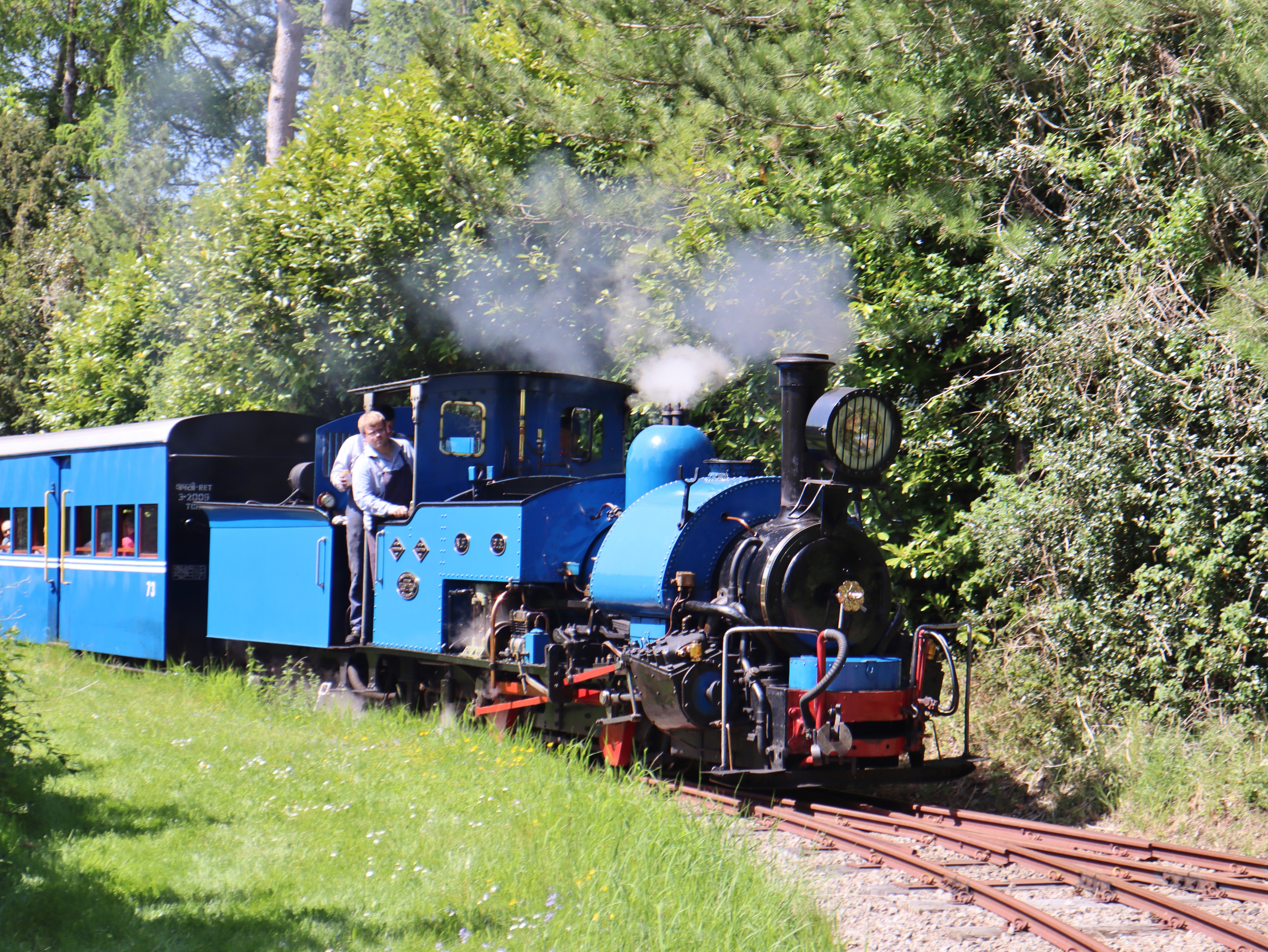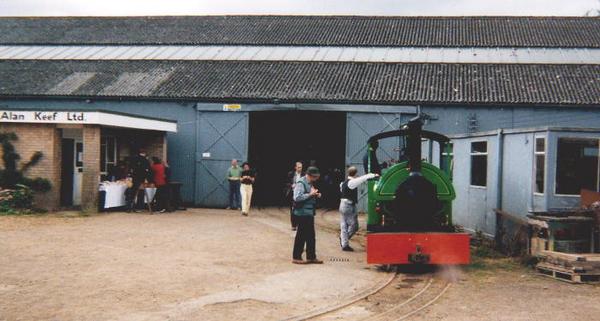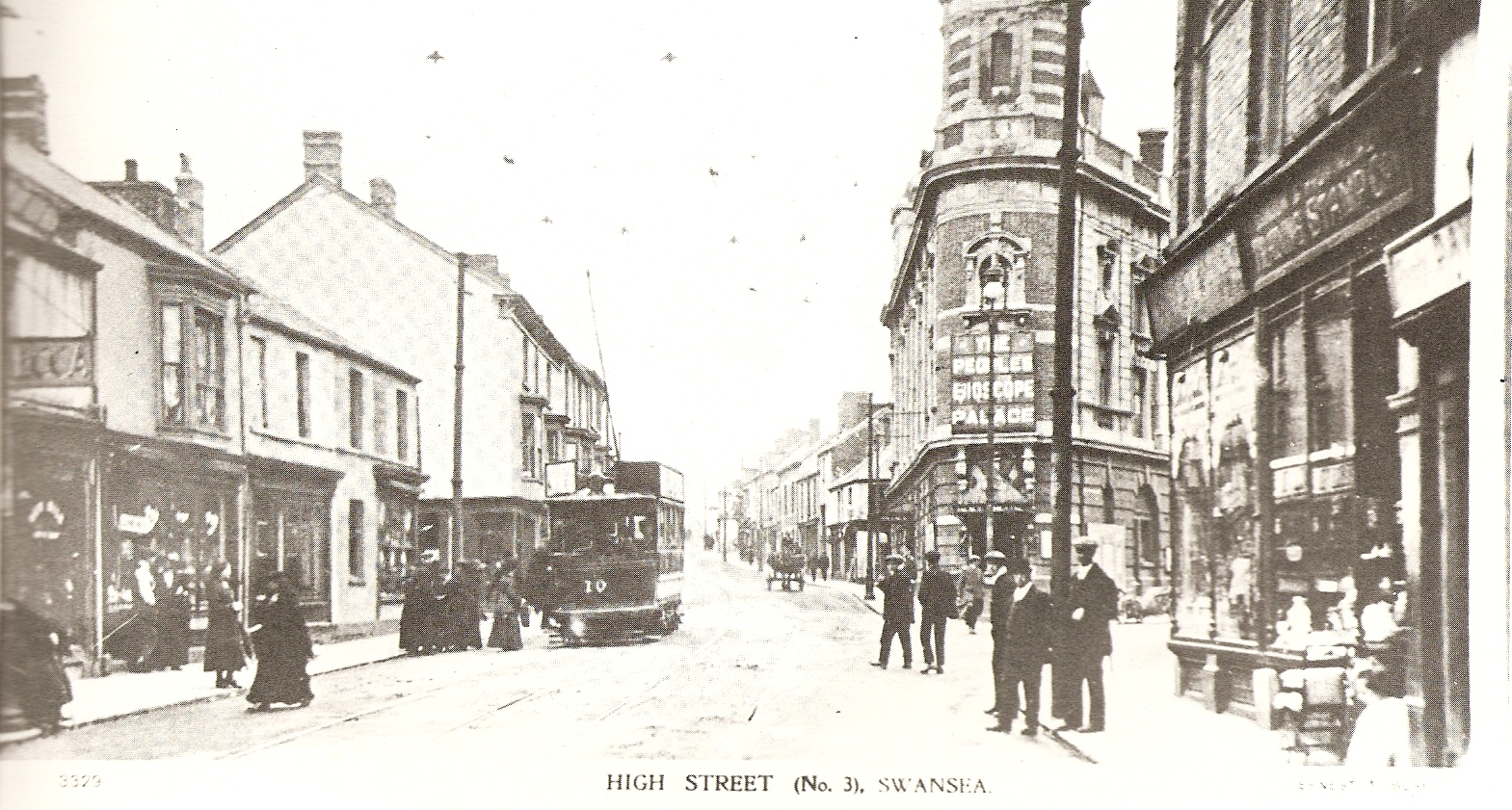|
Diana (locomotive)
''Diana'' is a narrow gauge steam locomotive. It was built by Kerr, Stuart and Company in 1909, and was delivered to the Kerry Tramway in Mid Wales, in 1917. After varied service in the Welsh slate industry, ''Diana'' was purchased by railway enthusiast Graham Mullis in 1964. After many years at a variety of location, ''Diana'' was purchased by a Talyllyn Railway volunteer in 2014, and restored to working order in 2015. Industrial service ''Diana'' was built in 1909 by Kerr, Stuart as part of an order for six gauge locomotives for Mauritius. Although several of the locomotives in the order were sent to Mauritius, ''Diana'' wasn’t delivered and stayed at Kerr, Stuart's factory in Stoke on Trent. In 1917, the locomotive was purchased by the Home Grown Timber Committee of the Board of Trade for use on the Kerry Tramway, near Newtown, Powys in Mid Wales. It was regauged to and delivered to Kerry, Powys. The Kerry Tramway closed in 1922, though a short length was retained, ... [...More Info...] [...Related Items...] OR: [Wikipedia] [Google] [Baidu] |
Vale Of Rheidol Light Railway
The Vale of Rheidol Railway () is a Narrow gauge railway, narrow gauge heritage railway in Ceredigion, Wales, between Aberystwyth and Devil's Bridge, Ceredigion, Devil's Bridge; a journey of . It opened in 1902 and, from the Withdrawal of steam on British Rail, withdrawal of main line steam on British Rail in 1968 until privatisation in 1989, it was the sole steam-operated line on the Transport Act 1947, 1948 nationalised British Rail network. It was one of the first parts of British Rail to be privatised. Unlike most other preserved railways in the United Kingdom, the Vale of Rheidol Railway did not have a period of closure between its being part of the national rail system and becoming a heritage railway, and so has operated a continuous service for residents and tourists. History Vale of Rheidol Light Railway Company A standard gauge railway in the Rheidol valley to the east of Aberystwyth was planned as part of the Manchester and Milford Railway route from Llanidloes to St ... [...More Info...] [...Related Items...] OR: [Wikipedia] [Google] [Baidu] |
Blaenau Ffestiniog
Blaenau Ffestiniog () is a town in Gwynedd, Wales. Once a slate mining centre in historic Merionethshire, it now relies much on tourists, drawn for instance to the Ffestiniog Railway and Llechwedd Slate Caverns. It reached a population of 12,000 at the peak development of the slate industry, but fell with the decline in demand for slate. The population of the community, including the nearby village Llan Ffestiniog, was 4,875 at the 2011 census: the fourth most populous in Gwynedd after Bangor, Caernarfon and Llandeiniolen. The population not including Llan is now only about 4,000. Etymology and pronunciation The meaning of Blaenau Ffestiniog is "uplands of Ffestiniog". The Welsh word ' is the plural of ' "upland, remote region". Ffestiniog here is probably "territory of Ffestin" (Ffestin being a personal name) or could possibly mean "defensive place". The English pronunciation of Blaenau Ffestiniog suggested by the ''BBC Pronouncing Dictionary of British Names'' is , but th ... [...More Info...] [...Related Items...] OR: [Wikipedia] [Google] [Baidu] |
Individual Locomotives Of Great Britain
An individual is one that exists as a distinct entity. Individuality (or self-hood) is the state or quality of living as an individual; particularly (in the case of humans) as a person unique from other people and possessing one's own needs or goals, rights and responsibilities. The concept of an individual features in many fields, including biology, law, and philosophy. Every individual contributes significantly to the growth of a civilization. Society is a multifaceted concept that is shaped and influenced by a wide range of different things, including human behaviors, attitudes, and ideas. The culture, morals, and beliefs of others as well as the general direction and trajectory of the society can all be influenced and shaped by an individual's activities. Etymology From the 15th century and earlier (and also today within the fields of statistics and metaphysics) ''individual'' meant " indivisible", typically describing any numerically singular thing, but sometimes meanin ... [...More Info...] [...Related Items...] OR: [Wikipedia] [Google] [Baidu] |
Statfold Barn Railway
The Statfold Barn Railway is a narrow gauge railway based near Tamworth, Staffordshire and partially in Warwickshire, England. Founded by engineering entrepreneur Graham Lee and his wife Carol at their farm-based home, they originally designed what is still termed the garden railway, in which Graham could run his trains and Carol could design an extensive English country garden around a lake. Graham Lee chaired the family-owned Wabtec, LH Group, with its main focus on railway engineering services. After LH Group acquired what remained of the Hunslet Engine Company in 2005, Graham pursued the opportunity to acquire the last steam locomotive built by Hunslet. Commissioned in 1971, it had been ordered by Leeds-based Robert Hudson & Co Ltd, who supplied and installed a complete railway system for the Trangkil sugar mill estate in Indonesia. As he pursued the Hunslet, Graham noticed a number of other interesting but defunct steam locomotives of European origin in Indonesia, and set ab ... [...More Info...] [...Related Items...] OR: [Wikipedia] [Google] [Baidu] |
Bala Lake Railway
The Bala Lake Railway ( Welsh: ''Rheilffordd Llyn Tegid'') is a narrow-gauge railway along the southern shore of Bala Lake in Gwynedd, North Wales. The line, which is long, is built on a section of the former standard-gauge Ruabon–Barmouth GWR route that closed in 1965. Another section of the former permanent way is used by the Llangollen Railway. The Bala Lake Railway, which runs on -gauge preserved rolling stock, is a member of the Great Little Trains of Wales. The railway now has the largest collection of historic narrow-gauge quarry locomotives built specifically for the Slate industry in Wales, slate industry in North Wales by the Hunslet Engine Company in Leeds. History Standard Gauge The narrow-gauge Bala Lake railway uses the permanent way of the former standard-gauge A standard-gauge railway is a railway with a track gauge of . The standard gauge is also called Stephenson gauge (after George Stephenson), international gauge, UIC gauge, uniform gauge, norm ... [...More Info...] [...Related Items...] OR: [Wikipedia] [Google] [Baidu] |
Aberystwyth
Aberystwyth (; ) is a University town, university and seaside town and a community (Wales), community in Ceredigion, Wales. It is the largest town in Ceredigion and from Aberaeron, the county's other administrative centre. In 2021, the population of the town was 14,640. Located in the Historic counties of Wales, historic county of Cardiganshire, means "the mouth of the River Ystwyth, Ystwyth". It has been a major educational location in Wales since the establishment of University College Wales, now Aberystwyth University, in 1872. The town is situated on Cardigan Bay on the west coast of Wales, near the confluence of the River Ystwyth and Afon Rheidol. Following the reconstruction of the harbour, the Ystwyth skirts the town. The Rheidol passes through the town. The seafront, with a Royal Pier, Aberystwyth, pier, stretches from Constitution Hill, Aberystwyth, Constitution Hill at the north end of the Promenade to the harbour at the south. The beach is divided by the castle. T ... [...More Info...] [...Related Items...] OR: [Wikipedia] [Google] [Baidu] |
Vale Of Rheidol Railway
The Vale of Rheidol Railway () is a Narrow gauge railway, narrow gauge heritage railway in Ceredigion, Wales, between Aberystwyth and Devil's Bridge, Ceredigion, Devil's Bridge; a journey of . It opened in 1902 and, from the Withdrawal of steam on British Rail, withdrawal of main line steam on British Rail in 1968 until privatisation in 1989, it was the sole steam-operated line on the Transport Act 1947, 1948 nationalised British Rail network. It was one of the first parts of British Rail to be privatised. Unlike most other preserved railways in the United Kingdom, the Vale of Rheidol Railway did not have a period of closure between its being part of the national rail system and becoming a heritage railway, and so has operated a continuous service for residents and tourists. History Vale of Rheidol Light Railway Company A standard gauge railway in the Rheidol valley to the east of Aberystwyth was planned as part of the Manchester and Milford Railway route from Llanidloes to St ... [...More Info...] [...Related Items...] OR: [Wikipedia] [Google] [Baidu] |
Alan Keef
Alan Keef Ltd is a British narrow gauge railway engineering company which manufactures, overhauls, and deals in narrow gauge locomotives, rolling stock and associated equipment. History The limited company was formed in 1975 at Cote, Oxfordshire, Cote, Bampton, Oxfordshire, continuing what Alan Keef had already been doing for some years as an individual. The first new locomotive was built in 1976. In 1986 the company moved to larger premises at Lea, Herefordshire, Lea, near Ross-on-Wye in Herefordshire. In 1987 it took over the production of Motor Rail locomotives. Production , the company had built more than eighty locomotives – steam, diesel and electric. Most have been miniature or narrow gauge except for two standard gauge steam locomotives for Beamish Museum: the replicas of "Steam Elephant" and "Puffing Billy (locomotive), Puffing Billy". In 2008 the company built the frames, running gear and mechanical parts for two Parry People Mover railcars for use on the Stourbr ... [...More Info...] [...Related Items...] OR: [Wikipedia] [Google] [Baidu] |
Swansea
Swansea ( ; ) is a coastal City status in the United Kingdom, city and the List of urban areas in the United Kingdom, second-largest city of Wales. It forms a Principal areas of Wales, principal area, officially known as the City and County of Swansea (). The city is the List of cities in the United Kingdom, twenty-eighth largest in the United Kingdom. Located along Swansea Bay in south-west Wales, with the principal area covering the Gower Peninsula, it is part of the Swansea Bay (region), Swansea Bay region and part of the Historic counties of Wales, historic county of Glamorgan and the ancient Welsh commote of Gŵyr. The principal area is the second most List of Welsh principal areas by population, populous local authority area in Wales, with an estimated population of in . Swansea, along with Neath and Port Talbot, forms the Swansea urban area, with a population of 300,352 in 2011. It is also part of the Swansea Bay City Region. During the 19th-century industrial heyday, ... [...More Info...] [...Related Items...] OR: [Wikipedia] [Google] [Baidu] |
Clydach, Swansea
Clydach is a village and community (Wales), community in Swansea, Wales, within the Clydach (electoral ward), Clydach ward and the Llangyfelach parish. It is located northeast of Swansea city centre. In 2011, the population was 7,503. Welsh language, Welsh is the first language of 24 per cent of the population and both Welsh language, Welsh and English language schools are available. The village lies close to the M4 motorway which can be accessed via the bypass or old road via Ynystawe. The community includes part of the village of Glais. History In the 1800s, Clydach was a very small community if it could even be called that. Maps from then show Clydach to consist of sub-areas namely 'Mount Pleasant' (the area by high street shops), 'Faerdre' (covering the area nearest to Vardre Road), 'Down' the area that was once 'Down Farm' which is now land laying behind the Farmer's Arms, Clydach and below 'Ty gwyn Road'. There was also an area called Ty Gwyn as Ty Gwyn/White House was pre ... [...More Info...] [...Related Items...] OR: [Wikipedia] [Google] [Baidu] |
Brecon Mountain Railway
The Brecon Mountain Railway (Welsh language, Welsh: ''Rheilffordd Fynydd y Bannau'') is a Narrow gauge railway, narrow gauge tourist railway on the south side of the Brecon Beacons in Wales. It climbs northwards from Pant railway station (Brecon Mountain Railway), Pant along the full length of the Pontsticill Reservoir (also called 'Taf Fechan' reservoir by Welsh Water) and continues past the adjoining Pentwyn Reservoir to Torpantau railway station. The railway's starting point at Pant is located north of the town centre of Merthyr Tydfil, Merthyr Tydfil County Borough, South-East Wales. Route description The line runs along part of the trackbed of the northern section of the former Brecon and Merthyr Railway from Pant, Merthyr Tydfil, Pant to a new station at Torpantau, via Pontsticill and Dolygaer, a total of about . This takes the BMR just short of the southern entrance to the 667 yd (610 m) long Torpantau tunnel, the highest railway tunnel in Great Britain, which carrie ... [...More Info...] [...Related Items...] OR: [Wikipedia] [Google] [Baidu] |
Llanberis Lake Railway
The Llanberis Lake Railway () is a narrow gauge heritage railway that runs for along the northern shore of Llyn Padarn in north Wales in the Snowdonia National Park. The starting point is the village of Llanberis at the eastern end of the lake (), with the western terminus at Pen Llyn in the Padarn Country Park (). The return journey takes around 60 minutes. The railway is one of the Great Little Trains of Wales. History Early proposals The Llanberis Lake Railway runs along part of the trackbed of the defunct Padarn Railway, a gauge line which connected the quarry with Y Felinheli (Port Dinorwic) on the Menai Strait. The Padarn Railway closed in October 1961 and was lifted between 16 May 1962 and February 1963. Following the closure of the Padarn Railway, various plans were made to open a gauge tourist railway on the trackbed. The first serious attempt was made by G. Ward, a local resident, who proposed a railway that would circle Llyn Padarn using the trackbeds of the ... [...More Info...] [...Related Items...] OR: [Wikipedia] [Google] [Baidu] |









